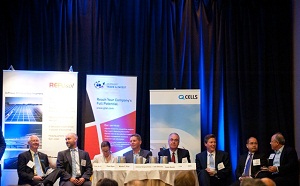The need for feed: Energy experts discuss feed-in tariffs for the U.S.
 The patchwork of state-led policies across the U.S. fails to create a real grid of reliable support for homeowners and others that want to install solar. This is particularly relevant as the U.S. is poised to become one of the largest solar markets in the world. But how to address that is a burning question that thus far no one—Congress, the White House, utilities or industry—has come up with a comprehensive solution. The night before the official opening of Intersolar, energy experts from Europe and the U.S. discussed the issue.
The patchwork of state-led policies across the U.S. fails to create a real grid of reliable support for homeowners and others that want to install solar. This is particularly relevant as the U.S. is poised to become one of the largest solar markets in the world. But how to address that is a burning question that thus far no one—Congress, the White House, utilities or industry—has come up with a comprehensive solution. The night before the official opening of Intersolar, energy experts from Europe and the U.S. discussed the issue.
The key issue is how best to pay people for generating solar power. There are many prevailing methods, including net metering, feed-in tariffs or feed-in rates, and solar renewable energy credits (SRECs), but there is no comprehensive policy that addresses how best to do this across the nation.
“I offer a radically simple suggestion, just set the [feed-in tariff] price at the prevailing wholesale electricity rate,” Dr. Eicke Weber, conference chairman and director of the Fraunhofer Institute for Solar Energy Systems of Germany, said during opening remarks.
He said such a rate would immediately benefit those states with higher electricity rates, encouraging more solar installations there, while states with lower electricity rates and lower sunlight levels would adopt more solar as it becomes less expensive. He added that under such a system there would be no arbitrariness to such rates.
Under a feed-in tariff, owners of solar systems would be able to lock-in long term, fixed rates for the power their system produces, Weber said. Such a scheme would benefit utilities as well, since they wouldn’t pay increasingly higher costs for the power produced by existing systems, unlike they would with fossil fuel systems.
But there are other factors at play in the U.S.
“Rate design matters,” said Kevin Fox, a partner with law firm Keyes & Fox, LLP.
Fox’s expertise lies in energy regulation and transformation.
“A lot of places in the country have a rate design that’s not friendly to solar, like a time-of-use rate,” he said. In addition, rates fluctuate based on the price of fuel stock, like natural gas or coal.
The complexity of pricing fossil fuel-based electricity further complicates the U.S. energy market.
“The regulatory system makes decisions 24-hours-per-day,” said John Geesman, co-chairman of the American Council On Renewable Energy (ACORE) Board of Directors. In the future, up to 70 percent of natural gas plant costs will be the purchase of the gas, he said.
“Jesus sets the fuel price,” he said. “No one’s paying attention, but 70 percent of that cost means you take more of that risk.”
Utilities in some U.S. states offer net metering to residents with solar installations and some of those offer actual reimbursements for power produced by the system that’s in excess of the power used by the system owners.
“About a third of states with net metering pay at avoided costs,” Fox said. “Net metering is not necessarily right for everyone.”
For instance, with multi-tenant buildings, residential or business, who benefits from such a system? One person or everyone? New legislation called virtual net metering, introduced in California, addresses such a situation, but it has yet to be realized.
“There’s another structure on the East Coast that’s worked out well,” said Rhone Resch, executive director of the Solar Energy Industries Association (SEIA). That’s the SREC mechanism, under which system owners can sell credits based on avoided pollution to utilities or other major polluters—depending on market and state requirements. Under such a scheme, system owners can sell the SRECs to the highest bidder.
Resch, who has a solar system on his home in Washington, D.C., said his system generated 10 SRECs for producing 10 megawatts. He had an opportunity to sell them at $200 a piece, but opted to wait. His broker called him a month later and told him he had an offer for $400 per credit, at which point he sold.
Story continues here.
Image courtesy of Intersolar.



